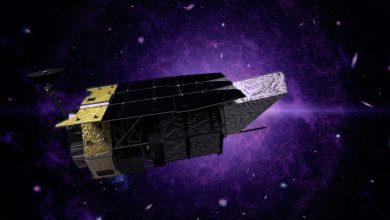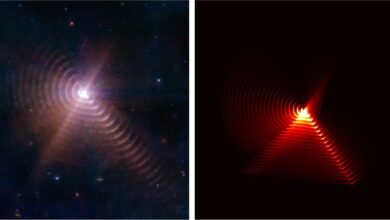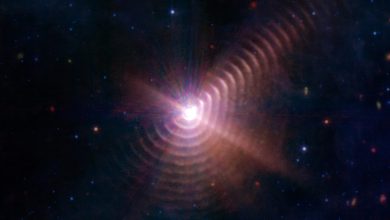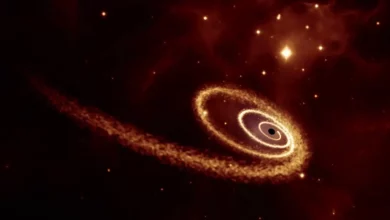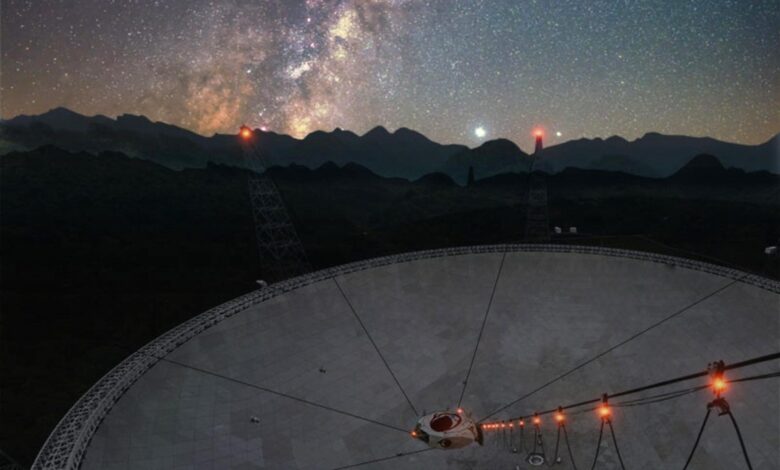
Lead Image: The Chinese Five-hundred-meter Aperture Spherical radio Telescope (FAST). Credit: Bojun Wang, Jinchen Jiang & Qisheng Cui
An international team reports on a radio pulsar phase of a Galactic magnetar that emitted a fast radio burst in 2020; observations suggest unique origins for “bursts” and “pulses,” which adds to FRB formation theory.
More than 15 years after the discovery of fast radio bursts (FRBs) – millisecond-long, deep-space cosmic explosions of electromagnetic radiation – astronomers worldwide have been combing the universe to uncover clues about how and why they form.
Nearly all FRBs identified have originated in deep space outside our Milky Way galaxy. That is until April 2020, when the first Galactic FRB, named FRB 20200428, was detected. This FRB was produced by a magnetar (SGR J1935+2154), a dense, city-sized neutron star with an incredibly powerful magnetic field.
This groundbreaking discovery led some to believe that FRBs identified at cosmological distances outside our galaxy may also be produced by magnetars. However, the smoking gun for such a scenario, a rotation period due to the spin of the magnetar, has so far escaped detection. New research into SGR J1935+2154 sheds light on this curious discrepancy.
In a recent issue of the journal Science Advances, an international team of scientists, including UNLV astrophysicist Bing Zhang, reported on the continued monitoring of SGR J1935+2154 following the April 2020 FRB, and the discovery of another cosmological phenomenon known as a radio pulsar phase five months later.
Unraveling a Cosmological Conundrum
To aid them in their quest for answers, astronomers rely in part on powerful radio telescopes like the massive Five-hundred-meter Aperture Spherical radio Telescope (FAST) in China to track FRBs and other deep-space activity. Using FAST, astronomers observed that FRB 20200428 and the later pulsar phase originated from different regions within the scope of the magnetar, which hints toward different origins.
“FAST detected 795 pulses in 16.5 hours over 13 days from the source,” said Weiwei Zhu, lead author of the paper from National Astronomical Observatory of China (NAOC). “These pulses show different observational properties from the bursts observed from the source.”
This dichotomy in emission modes from the region of a magnetosphere helps astronomers understand how – and where – FRBs and related phenomena occur within our galaxy and perhaps also those at further cosmological distances.
Understanding Radio Pulses and Magnetars
Radio pulses are cosmic electromagnetic explosions, similar to FRBs, but typically emit a brightness roughly 10 orders of magnitude less than an FRB. Pulses are typically observed not in magnetars but in other rotating neutron stars known as pulsars. According to Zhang, a corresponding author on the paper and director of the Nevada Center for Astrophysics, most magnetars do not emit radio pulses most of the time, probably due to their extremely strong magnetic fields. But, as was the case with SGR J1935+2154, some of them become temporary radio pulsars after some bursting activities.
Another trait that makes bursts and pulses different are their emission “phases,” i.e. the time window where radio emission is emitted in each period of emission.
“Like pulses in radio pulsars, the magnetar pulses are emitted within a narrow phase window within the period,” said Zhang. “This is the well-known `lighthouse’ effect, namely, the emission beam sweeps the line of sight once a period and only during a short interval in time in each period. One can then observe the pulsed radio emission.”
Zhang said the April 2020 FRB, and several later, less energetic bursts were emitted in random phases not within the pulse window identified in the pulsar phase.
“This strongly suggests that pulses and bursts originate from different locations within the magnetar magnetosphere, suggesting possibly different emission mechanisms between pulses and bursts,” he said.
Implications for Cosmological FRBs
Such a detailed observation of a Galactic FRB source sheds light on the mysterious FRBs prevailing at cosmological distances.
Many sources of cosmological FRBs – those occurring outside our galaxy – have been observed to repeat. In some instances, FAST has detected thousands of repeated bursts from a few sources. Deep searches for seconds-level periodicity have been carried out using these bursts in the past and so far no period was discovered.
According to Zhang, this casts doubt on the popular idea that repeating FRBs are powered by magnetars in the past.
“Our discovery that bursts tend to be generated in random phases provides a natural interpretation to the non-detection of periodicity from repeating FRBs,” he said. “For unknown reasons, bursts tend to be emitted in all directions from a magnetar, making it impossible to identify periods from FRB sources.”
Reference: “A radio pulsar phase from SGR J1935+2154 provides clues to the magnetar FRB mechanism” by Weiwei Zhu, Heng Xu, Dejiang Zhou, Lin Lin, Bojun Wang, Pei Wang, Chunfeng Zhang, Jiarui Niu, Yutong Chen, Chengkui Li, Lingqi Meng, Kejia Lee, Bing Zhang, Yi Feng, Mingyu Ge, Ersin Göğüş, Xing Guan, Jinlin Han, Jinchen Jiang, Peng Jiang, Chryssa Kouveliotou, Di Li, Chenchen Miao, Xueli Miao, Yunpeng Men, Chenghui Niu, Weiyang Wang, Zhengli Wang, Jiangwei Xu, Renxin Xu, Mengyao Xue, Yuanpei Yang, Wenfei Yu, Mao Yuan, Youling Yue, Shuangnan Zhang and Yongkun Zhang, 28 July 2023, Science Advances.
DOI: 10.1126/sciadv.adf6198

